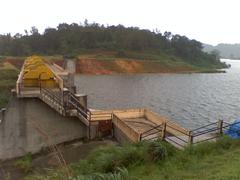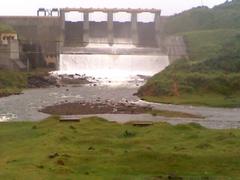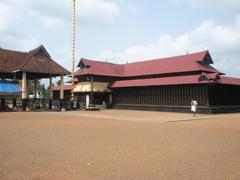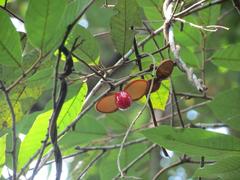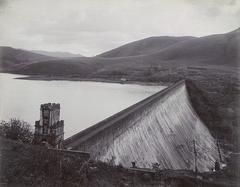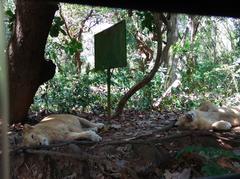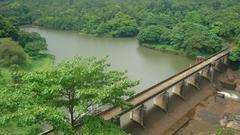
Banasura Sagar Dam: Visiting Hours, Tickets, and Comprehensive Travel Guide
Date: 14/06/2025
Introduction: Why Visit Banasura Sagar Dam?
Banasura Sagar Dam, nestled in the lush hills of Wayanad, Kerala, stands as India’s largest earthen dam and the second largest in Asia (Kerala Tourism; Wikipedia). This engineering marvel, built across the Karamanathodu River in the foothills of the Western Ghats, is much more than a reservoir—it is a vibrant hub for eco-tourism, adventure, and an immersion into Kerala’s natural and cultural heritage. The dam, named after the mythological figure Banasura, offers panoramic views, unique island formations during the monsoon, and close proximity to several Wayanad historical sites, making it a must-visit destination for travelers seeking both tranquility and adventure (TravelTriangle; Tripoto).
Historical and Cultural Significance
Origins and Construction
The conception of Banasura Sagar Dam dates back to the early 1970s, aiming to address Wayanad’s needs for irrigation, drinking water, and hydroelectric power (Kerala Hydel Tourism). Construction began in 1972 and was completed in 1979, resulting in an earthen dam stretching 776 meters long and rising to about 38.5 meters in height (Wikipedia). Utilizing local soil and boulders, the dam harmonizes with its natural surroundings and is supported by multiple saddle dams for enhanced storage (BanasuraSagarDam.com).
Purpose and Achievements
- Irrigation: The dam’s reservoir ensures a steady water supply to local farmlands, mitigating seasonal shortages (Travel.Earth).
- Hydroelectric Power: Water is diverted to the Kuttiyadi Hydro Electric Project, generating significant electricity for the region.
- Drinking Water: The dam supports nearby communities, especially during the dry season.
- Sustainability: Notably, the reservoir hosts India’s first floating solar power plant, integrating renewable energy into its operations (Wikipedia).
Cultural and Mythological Roots
Named after the mythic king Banasura, the dam and surrounding hills are steeped in legend, enriching the local folklore and adding a cultural dimension to the visitor experience (Kerala Hydel Tourism). The Western Ghats, where the dam is situated, are a UNESCO World Heritage Site, further elevating its ecological and cultural value (BanasuraSagarDam.com).
Geographical Setting and Ecological Significance
Location and Climate
Banasura Sagar Dam is approximately 21–22 km northeast of Kalpetta, the district headquarters of Wayanad (hiwayanad.in; keralatravelpal.com). Set amidst the rolling hills of the Western Ghats, the landscape is lush year-round, with monsoon rains (June–September) transforming the area into a vibrant green paradise (keralatouristplaces.org).
Ecological Hotspot
The dam and its reservoir support a rich diversity of flora and fauna, attracting migratory birds and creating microhabitats that are vital to the Western Ghats’ ecosystem (Viacation). The surrounding forests are home to elephants, leopards, Malabar giant squirrels, and rare bird species.
Accessibility: Getting to Banasura Sagar Dam
- By Road: Private vehicles and taxis are the most convenient, with ample parking at the site. Public buses from Kalpetta and Padinjarathara (2–3 km from the dam) also serve the area (hiwayanad.in; keralatravelpal.com).
- By Rail: Kozhikode (Calicut) Railway Station is the nearest, about 88–105 km away. Taxis and buses connect Kozhikode to Kalpetta and onward to the dam (traveltriangle.com).
- By Air: Calicut International Airport (CCJ) is approximately 97–132 km from the dam. Taxis or connections via Kozhikode city are available (hiwayanad.in).
Visiting Hours and Ticket Information
- Hours: 8:00 AM to 6:00 PM daily (hiwayanad.in; eindiatourism.in).
- Entry Fee: ₹10 for Indian nationals, ₹50 for foreigners. Parking: ₹10 per vehicle (eindiatourism.in).
- Boating Tickets: Purchased on-site, with fees ranging from INR 50–500 depending on the type of boat and duration. Speed boating is especially popular—arrive early to secure tickets (trawell.in).
On-Site Facilities
- Parking: Ample space for cars and buses.
- Restrooms: Basic facilities are available.
- Food: Small stalls near Padinjarathara; for full meals, head to Kalpetta.
- Accessibility: Main approach is gently sloped; certain trekking trails and some boat boarding areas may be challenging for those with mobility issues.
Top Activities at Banasura Sagar Dam
Boating and Water Sports
- Speed Boating: The highlight activity, offering thrilling rides and panoramic views.
- Pedal and Row Boats: Tranquil options suited for couples and families.
Trekking and Nature Walks
- Trails in the Banasura Hills offer wildlife spotting and breathtaking vistas (thrillophilia.com).
Adventure and Family Fun
- Pony Rides and Play Areas: Fun for children.
- Picnicking: Well-maintained gardens ideal for families.
Photography
- Early morning and late afternoon provide the best light for capturing the dam, reservoir, and surrounding hills.
Cultural and Wildlife Experiences
Indigenous Communities and Heritage
The region is home to several Adivasi groups, including the Kadar, Kurichiya, and Paniya, whose traditions and sustainable practices have shaped Wayanad’s landscape (Frontiers in Sustainable Tourism, 2024). Cultural festivals and eco-tourism events occasionally showcase their music, crafts, and rituals.
Wildlife Sanctuaries
Nearby sanctuaries such as Wayanad Wildlife Sanctuary and Brahmagiri Sanctuary offer safaris and birdwatching, with the chance to see elephants, tigers, and endemic birds (traveltriangle.com).
Responsible Tourism and Conservation
- Support local communities: Book guided tours with local operators and purchase authentic handicrafts.
- Minimize waste: Carry reusable bottles and avoid single-use plastics.
- Respect local customs and nature: Stay on marked trails, avoid disturbing wildlife, and seek permission before photographing local people or sacred sites.
- Choose eco-friendly accommodations: Prioritize stays that practice sustainability, such as waste segregation and water conservation.
The ecological balance of the region is delicate—deforestation, unregulated tourism, and monoculture plantations have contributed to soil erosion and biodiversity loss. Flood events in recent years have further underscored the need for sustainable tourism and habitat conservation (Frontiers in Sustainable Tourism, 2024).
Notable Nearby Wayanad Attractions
- Edakkal Caves: Prehistoric carvings and petroglyphs, 25–40 km away (travelerbibles.com).
- Meenmutty Waterfalls: A three-tiered, 300-meter waterfall accessible via a forest trek (thrillophilia.com).
- Kuruva Island: A 950-acre river delta with bamboo rafting (indriyawayanad.com).
- Pookode Lake: Boating, children’s park, and aquarium (travelerbibles.com).
- Chembra Peak: Treks to Wayanad’s highest point and heart-shaped lake.
Accommodation Options
Choose from resorts near the reservoir (such as Banasura Island Resort and Sharoy Resort) or hotels and homestays in Kalpetta, all offering easy access to the dam and other attractions (eindiatourism.in).
Practical Tips for Visitors
- Best Time: October–May for pleasant weather and full activity access; June–September for lush monsoon scenery.
- Duration: A visit typically takes 2–3 hours, but allow a full day if exploring nearby sites.
- Footwear: Non-slip shoes are recommended, especially in the rainy season.
- Connectivity: Mobile coverage is generally good but may be weak in remote forested areas.
- Advance Bookings: Essential during peak season for accommodation and adventure activities.
Frequently Asked Questions (FAQ)
Q: What are the visiting hours?
A: 8:00 AM to 6:00 PM daily.
Q: How much is the entry fee?
A: ₹10 for Indian nationals, ₹50 for foreigners.
Q: Are boats available?
A: Yes—speed boats, pedal boats, and rowboats are available.
Q: Is the dam accessible for differently-abled visitors?
A: Basic accessibility is provided, but some areas require assistance.
Q: Are guided tours available?
A: Yes, through local operators or by booking in advance in Kalpetta.
Visual Resources
Internal Links
Map Coordinates
- Google Map Plus Code: MXC5+24 Padinjarathara, Kerala (keralatouristplaces.org)
Conclusion
Banasura Sagar Dam exemplifies Kerala’s harmonious blend of nature, culture, and sustainable development. As a premier Wayanad attraction, it invites travelers to experience breathtaking landscapes, adventure, and a living tapestry of history and indigenous heritage. Responsible tourism is essential to preserving the region’s ecological and cultural wealth, ensuring that future generations can continue to enjoy this remarkable destination. For the latest updates, ticket bookings, and travel tips, download the Audiala app and follow us on social media.
Sources and Further Reading
- Banasura Sagar Dam: Visiting Hours, Tickets, and Exploring Wayanad’s Historical Gem, 2025, TravelTriangle
- Banasura Sagar Dam Visiting Hours, Tickets, and Travel Guide to Wayanad Historical Sites, 2025, HiWayanad
- Banasura Sagar Dam Visiting Hours, Tickets, and Attractions in Wayanad, 2025, eIndiaTourism
- Banasura Sagar Dam: Visiting Hours, Tickets, Cultural and Ecological Insights in Wayanad, 2025, Frontiers in Sustainable Tourism
- Kerala Tourism Official Site, 2025
- Wikipedia: Banasura Sagar Dam, 2025
- Kerala Hydel Tourism, 2025
- Tripoto: Banasura Sagar Dam, 2025
- Viacation: Banasura Sagar Dam, 2025
